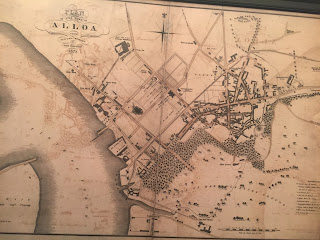 |
| Stirling Castle, looking across to Wallace Monument |
The weather was a bit gloomy this morning, misty and
atmospheric although still dry and fairly mild; great conditions for our visit
to Stirling Castle. The castle is sited at a strategic location between the
Firths of Clyde and Forth – a relatively narrow landmass which people needed to
traverse to move between southern and northern Scotland – and up high on a
rocky hill with views for miles. (Though as Levi pointed out, it can’t have
been all that great a position given that it changed hands 8 times in 50 years
at one point!)
There were lots of people visiting the castle, but they seemed
to all spread out so we didn’t feel cramped. One of the things that struck me
here is that a castle isn’t a single building, but really a whole village
within the castle walls. Stirling Castle has really informative and interesting
displays of the history of the Scottish monarchy (history that we just don’t learn,
growing up here in NZ). One really interesting part was that some years ago
they found 9 skeletons buried within the castle walls, suggesting that they may
have died during a period when the castle was under siege and the usual burial
grounds couldn’t be reached. They’ve done forensic analysis on these skeletons,
and pieced together stories about two of the people. The male was built “like a
professional rugby player” based on his huge shoulder blades; he had a 2-inch
forehead wound in his skull (though it had healed so it wouldn’t have been what
killed him – that was likely the arrow-head found in his chest); and it’s
thought he was a knight, due to his bowed legs! In a couple of rooms in the
castle there were actors dressed in period costume and talking in character to
visitors about royal life in the castle.
Leaving the Castle, we decided we didn’t have time to climb the Wallace Monument, also in Stirling – a real shame, I was looking forward to its 296 steps and views out through the mist…not!
 |
| View from roof of Alloa Tower |
I’m not sure of the original internal layout of the rooms in
Alloa Tower, but now each floor is just one large room, all connected by a very
narrow, very steep spiral staircase – how on earth a family could have lived
there with children I don’t know! The spiral staircase goes all the way up and
out on to the roof... I didn’t last long up there, it was very a long way down!
Levi wasn’t very keen on it either - especially with the signs saying “don’t
lean on barriers, they may not support your weight”.
 |
| 1825 map in Alloa Tower, showing Bald properties |
On the second floor there was a staff member on full-time
duty, as the walls on this level of the tower are covered with old and valuable
family portraits. There are also other information resources here, so we spent
some time looking through various local history books for references to the
Bald family, and found several. The coolest thing though, was the woman on the
entry/ticket desk knowing of the Bald family – her husband used to work for the
(now defunct) Carsebridge Distillery, originally run by John Bald – and telling
us where to find Robert Bald’s house. And then on the wall we found an old map,
from 1825… which shows Ro. Bald Esqr’s property, as well as Mr [Alexander] Bald’s
wood yard on the edge of the forth. The timber yard is long gone, and the site
is now just a carpark and little commemorative path inscribed with key points in
the history of the town, but Robert’s house is still standing and apparently occupied.
From the picture the receptionist at Alloa Tower gave me, Robert’s house is grander
at the back than it is at the front, but it was still obviously a pretty substantial residence. At the house I had a
similar feeling to how I’d felt at Anne’s grave, knowing that it was very
likely that William would have visited there at times.
 |
| Alexander Bald's house, 14 Bedford Pl, Alloa (Lylestone House) |
One funny thing at Alloa Tower: I couldn’t use Irish currency for the entry ticket; notes from the Bank of Ireland and Bank of Ulster seem to be accepted in shops, but the National Trust of Scotland wouldn’t take them. (I’ve had GBP currency from Banks of Ireland, Ulster, Scotland and England on this trip, all different sizes and colours. And now it’s apparent that all aren’t quite equally valued! And the coins!!... They still use 1p and 2p and 5p coins; purse has been full of damn shrapnel the whole time, grr!)
 |
| Driving through Culross |
 |
| View from the Beach House across the Firth of Forth to Edinburgh |

